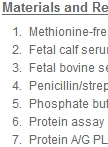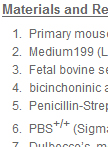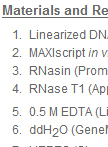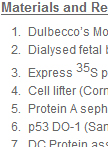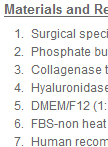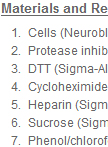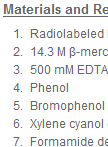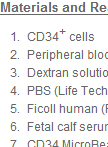往期刊物2012
卷册: 2, 期号: 21
生物化学
Protein Translation Study – Label Protein with S35 Methionine in Cells
蛋白质转译研究-—用S35蛋氨酸标记细胞中的蛋白质
To follow protein synthesis, cells should be incubated with radioactive amino acid such as [35S] methionine during mRNA translation. Then, the neosynthetized protein will be identified by an autoradiography after immunoprecipitation with a specific antibody and separation on a polyacrylamide denaturing gel.
Glucose Production Assay in Primary Mouse Hepatocytes
原代小鼠肝细胞中的葡萄糖生成分析
Hepatic glucose production is a primary determinant of fasting hyperglycemia in type 2 diabetic patients. Glucagon-cAMP-PKA pathway increases, but insulin-PI3 kinase-Akt pathway suppresses glucose production. This assay aims to evaluate the ability of isolated mouse hepatocytes to release newly synthesized glucose mainly from lactate and pyruvate as the substrates (i.e. gluconeogenesis) under basal, cAMP-, or cAMP plus insulin-treated condition.
In vitro RNA-protein Binding Assay by UV Crosslinking
采用紫外交联进行体外RNA-蛋白质结合试验
Because covalent bond can form between RNA and its binding proteins after UV irradiation, UV cross-linking is widely used to identify the specific RNA binding proteins. This protocol is described in details as follows.
Analyze p53 degradation by 35S p53 Pulse Chase Analysis
采用35S p53 脉冲追踪分析 p53降解
p53, is known as the guardian of the genome and as such requires exquisite regulation not only of its abundance but also its activity. The abundance of p53 can be modulated at the level of transcription, translation, and also via its degradation.This protocol involves 35S metabolic labelling of newly synthesized proteins followed by a period of chase with "cold" media. Samples are harvested and p53 immunopreciptiated, separated by SDS PAGE and the levels of 35S labelled p53 determined. By comparing the level of 35S p53 at 0 h to those "chased" with cold media (e.g. 60 min) provides an indication of the rate of p53 turnover.
癌症生物学
Establishing Primary Malignant Pleural Mesothelioma (MPM) Cell Cultures
原代恶性胸膜间皮瘤(MPM)的细胞培养
This is a general protocol for the isolation and maintenance of primary MPM cultures as a tool for the identification of Tumor Initiating Cells and early progenitor-targeting drugs (Cioce et al., 2010). Primary cultures can be propagated efficiently for 8-12 weeks and xenotransplanted in NOD/SCID mice while retaining the histofeatures of the originating tumor (Canino et al., 2012). The protocol is suitable for both MPM solid specimens and pleural effusion. For increased clarity, initially two separate sections addressing the isolation of MPM cells from solid tumors and pleural effusions are here provided.
分子生物学
Polysome Preparation, RNA Isolation and Analysis
多核糖体的制备、RNA分离和分析
During mRNA translation, 40S and 60S ribosomal subunits bind to target mRNA forming into an 80S complex (monosome). This ribosome moves along the mRNA during translational elongation to facilitate tRNA reading codon, where translation is activated and many monosomes can bind the same mRNA simutaneously, which forms polysomes. Polysomes can be size-fractionated by sucrose density gradient centrifugation. The more specific mRNA in polysomes implies more active translational status of the mRNA.
KMnO4 Footprinting
高锰酸钾足迹法
The KMnO4 footprinting method offers a rapid and easy way to detect and localize single-stranded regions within a duplex DNA molecule, such as it occurs for instance within an actively transcribing RNA polymerase-DNA complex or during R-loop formation in DNA-RNA hybrid structures. The method is based on the selective oxidation of single-stranded thymines in DNA. The modified nucleotides react with strong bases by ring opening and subsequent phosphodiester cleavage. Because the modified nucleotides will not be recognized by DNA polymerase sites of modification can also be analyzed by primer extension with Klenow DNA polymerase, which stops elongation one residue before the modification. Hence, localization of the modified base positions can be performed on denaturing polyacrylamide gels either after piperidine catalyzed phosphodiester cleavage of 3'- or 5'-32P-end-labeled DNA or by primer extension with non-labeled DNA employing 32P-labeled oligonucleotide primers. Due to the fact that KMnO4 can penetrate through membranes the footprinting method can also be used for footprint analyses within living cells.
干细胞
Isolation of Human Blood Progenitor and Stem Cells from Peripheral Blood by Magnetic Bead
磁珠法从外周血液中分离人血前体细胞和干细胞
The antigen CD34 is a well-known marker present on human progenitor and stem cells. This protocol explains the isolation of CD34+ cells from peripheral blood using magnetic bead separation technique. The approximate abundance of CD34+ cells in blood is 0.1% of mononuclear cells.


